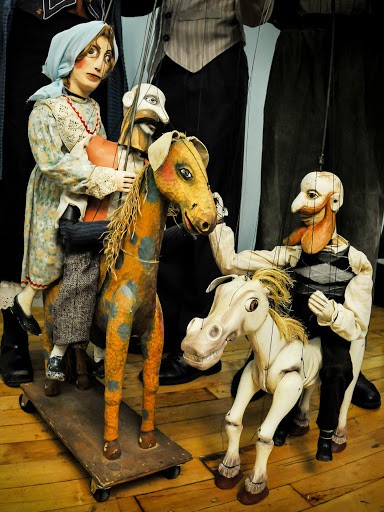Czechoslovak-American Marionette Theatre's King Executioner
Theater for the New City March 21 to April 7
By: Ariel Petrova - Mar 12, 2013
Czechoslovak-American Marionette Theatre presents "King Executioner," written and directed by Vit Horejš with musical score by Frank London (The Klezmatics). This enigmatic tale of early World War II is based on a novel by Polish magical realist Tadeusz Nowak.
Theater for the New City, 155 First Ave., presents the work March 21 to April 7. Shows are Th-Sat at 8:00 PM and Sun at 3:00 PM. The running time is 1:10.
The play is loosely based on "When you are a King, You will be an Executioner" ("A Jak Krolem a Jak Katem Bedzies," 1968) by the Polish magical realist novelist Tadeusz Nowak (1930-1991). This novel, which has never been published in English, is an allegorical tale of Polish peasant life in the early days of the German invasion. It unfolds like a 20th century folk tale, narrating a farm boy's bumpy journey to manhood. The boy goes to fight with the partisans after the German invasion and his patriotic duty compels him to kill two neighbors he's known all his life. As he faces decisions about life and death for others, his story becomes a parable on the complex truths of existence and dignity.
Seven performers will play multiple characters and interact with puppets of many sizes and styles, including traditional Czech marionettes, toy marionettes, shadow puppets and oversize puppets. In his unique hybrid staging method, Horejš conceives each character as a double--live performer and puppet--with inner dialogues being revealed amid several levels of subtext. Differing puppet sizes are used to create cinematic effects: close-ups, long shots and zooms.
Music by Frank London (www.franklondon.com) will use traditional Polish songs as well as original Klezmer compositions and incidental music. The lyrics by Vit Horejš are written in Nowak's dreamy prose style. The three onstage musicians will also play characters in the play: a band of Jewish musicians who are wiped out by the Nazis together with their shtetl.
The play will be staged before three "crankies," scrolling backgrounds of different sizes, all painted by Theresa Linnihan, rendered in black and white and lit in amber to suggest old sepia photographs. The puppets will range in size from eight inches to twelve feet. The miniature ones--representing resistance fighters, policemen and bystanders--are by Milos Kasal and are cast using molds from the 1920s. The principal characters are portrayed by 28" wooden marionettes designed and carved by Jakub Krejci in his Prague workshop. One giant puppet is by Theresa Linnihan. There are about 20 puppets in all.




